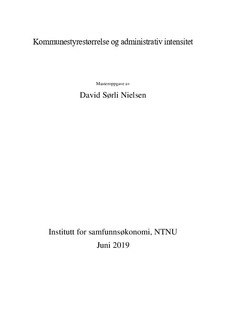| dc.contributor.advisor | Rattsø, Jørn | |
| dc.contributor.author | Nielsen, David Sørli | |
| dc.date.accessioned | 2019-09-05T14:00:29Z | |
| dc.date.available | 2019-09-05T14:00:29Z | |
| dc.date.issued | 2019 | |
| dc.identifier.uri | http://hdl.handle.net/11250/2612740 | |
| dc.description.abstract | Denne oppgaven ser på effekten av kommunestyrets størrelse på administrativ intensitet i norske kommuner mellom 2001 og 2016. Jeg viser at datagrunnlaget ikke støtter bruk av verken regression discontinuity design eller difference in differences. En standard paneldatamodell med faste effekter gir motsatt fortegn på kommunestyrestørrelsen avhengig av kommunens størrelse. Begge effektene er signifikante ved 95% konfidensnivå. Små kommuner får lavere administrativ intensitet av å redusere kommunestyrestørrelsen. Store kommuner får høyere administrativ intensitet av å redusere kommunestyrestørrelsen, i tråd med en standard byråkratimodell (Niskanen 1971). Ved bruk av coarsened exact matching (CEM) og følsomhetsanalyse av kontrollvariablene blir effekten for små kommuner ikke signifikant. For store kommuner med høy administrativ andel ved periodens start blir effekten større og signifikant ved 99% nivå. En reduksjon av kommunestyrestørrelsen for denne gruppen gir 0.818 prosentpoeng høyere administrasjonskostnader som andel av totale kostnader. For mediankommunen i denne gruppen utgjør det omkring 3.1 millioner kroner årlig. | |
| dc.description.abstract | This paper looks at the effect of council size on administrative intensity in Norwegian municipalities between 2001 and 2016. I show that the data does not support the use of neither regression discontinuity design nor difference in differences. A standard panel data model with fixed effects gives an opposite sign for the effect of council size, depending on the size of the municipality. Both effects are significant at 95% confidence level. Small municipalities reduce their administrative intensity by reducing council size. Large municipalities increase their administrative intensity by reducing council size, as predicted by standard bureaucracy models (Niskanen 1971). Using coarsened exact matching (CEM) and a sensitivity analysis of the control variables makes the effect for small municipalities insignificant. The effect increases for large municipalities starting the period with high administrative intensity, and the effect is significant at the 99% confidence level. A reduction in council size for this particular group increases administration costs by 0.818 percentage points as a share of total costs. This equals around 3.1 million kroner a year for the median municipality in this group. | |
| dc.language | nob | |
| dc.publisher | NTNU | |
| dc.title | Kommunestyrestørrelse og administrativ intensitet | |
| dc.type | Master thesis | |
